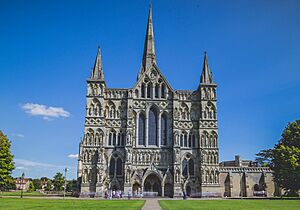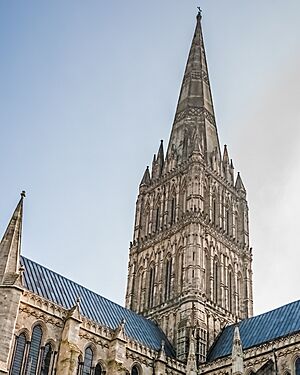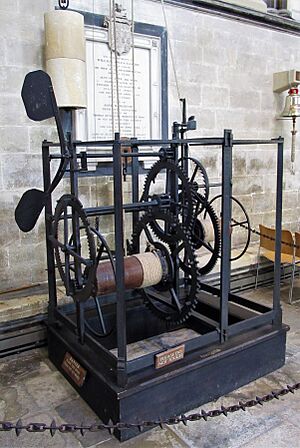Salisbury Cathedral facts for kids
Quick facts for kids Salisbury Cathedral |
|
|---|---|
| Cathedral Church of the Blessed Virgin Mary, Salisbury | |
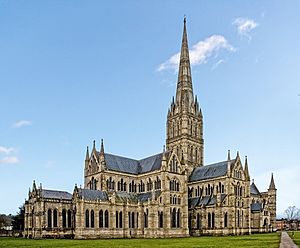
Salisbury Cathedral from the north-east
|
|
| Lua error in Module:Location_map at line 420: attempt to index field 'wikibase' (a nil value). | |
| Location | Salisbury, Wiltshire |
| Country | England |
| Denomination | Church of England |
| Churchmanship | Anglo-Catholic |
| Architecture | |
| Previous cathedrals | 2 |
| Architect(s) | Richard Poore; Elias of Dereham (possibly) |
| Style | Early English Gothic |
| Years built | 1220–1330 |
| Groundbreaking | 1220 |
| Specifications | |
| Length | 442 feet (135 m) |
| Nave length | 234 feet (71 m) |
| Nave width | 78 feet (24 m) |
| Choir height | 84 feet (26 m) |
| Number of towers | 1 |
| Tower height | 225 feet (69 m) (without spire) |
| Number of spires | 1 |
| Spire height | 404 feet (123 m) |
| Administration | |
| Diocese | Salisbury (since 1220) |
| Province | Canterbury |
Salisbury Cathedral, also known as the Cathedral Church of the Blessed Virgin Mary, is a large church in Salisbury, England. It belongs to the Church of England. This cathedral is the main church for the Diocese of Salisbury. It is also where the Bishop of Salisbury has his official seat.
The building is a great example of Early English Gothic architecture. Most of the cathedral was built very quickly, in just 38 years. This happened between 1220 and 1258. The tall tower and spire were finished by 1330. The spire reaches 404 feet (123 m) high. It has been the tallest church spire in England since 1561. The cathedral also has one of the oldest working clocks in the world. It is also home to one of the four original copies of the famous Magna Carta. In 2008, the cathedral celebrated 750 years since it was officially opened.
Contents
History of Salisbury Cathedral
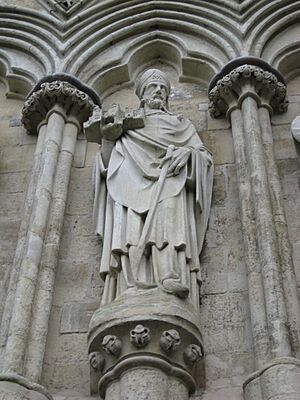
The city of Salisbury became home to a bishop in 1075. At that time, the city was located at a place called Old Sarum. This was on a hill about 2 miles (3.2 km) north of where the cathedral stands today. The first Old Sarum Cathedral was built there and opened in 1092.
Around 1197, Bishop Herbert Poore wanted to move the cathedral. This was possibly because of problems between the church leaders and the soldiers at Old Sarum. Permission was given, but the move was delayed. It finally happened when his brother, Richard Poore, became bishop. A story says that Bishop Poore shot an arrow to decide where to build the new cathedral. The arrow hit a deer, which died at the spot where Salisbury Cathedral is now.
Building the cathedral was paid for by donations. Many church leaders from southeast England gave a set amount of money each year. The first foundation stones were laid on April 28, 1220. Important people like William Longespée, 3rd Earl of Salisbury and Ela of Salisbury, 3rd Countess of Salisbury helped lay them. Much of the stone came from a nearby quarry called Teffont Evias. The new site had a high water table, meaning there was water close to the surface. Because of this, the cathedral was built on foundations only 4 feet (1.2 m) deep.
By 1258, the main parts like the nave, transepts, and choir were finished. Since it was built so quickly, Salisbury Cathedral has a very consistent architectural style. This style is called Early English Gothic. It is also known as Lancet Gothic because of its tall, narrow windows that are not divided by stone patterns.
The cloisters were added in 1240. The chapter house was built in 1263. The tall tower and spire were the last major parts. They were finished around 1330 and reached 404 feet (123 m) high. In total, builders used 70,000 tons of stone, 3,000 tons of wood, and 450 tons of lead. When it was finished, Salisbury's spire was the highest stone spire in England.
In the 1600s, architect Christopher Wren helped strengthen the central pillars. These pillars were bending under the weight of the tower and spire. Later, in 1790, architect James Wyatt made big changes. He removed the original screen that separated the choir from the nave. He also tore down a bell tower that stood near the main building.
Recent Events at the Cathedral
In February 2016, a sculpture called The Kiss was placed on the cathedral grounds. It was moved quickly because people kept bumping into it while looking at their phones.
In October 2018, someone tried to take the cathedral's copy of Magna Carta. Alarms went off, and a man was later arrested. The glass case holding the document was damaged, but the Magna Carta itself was safe. In January 2020, Mark Royden was found guilty of trying to steal it.
From January 2021, during the COVID-19 pandemic, the cathedral was used as a vaccination center. Music was played on the organ while people received their shots. In February 2024, the outside of the cathedral could be seen fully for the first time in 38 years. This was after a long period of renovation work.
Cathedral Design and Architecture
The West Front
The west front is the main entrance side of the cathedral. It looks like a screen, similar to the one at Wells Cathedral. It has two stair towers at each end. There are also two buttresses closer to the middle that support a large central window. The stair towers have small spires on top. The middle section has a gable with four tall windows. Above these are two round windows and a special oval shape with a carving of Christ in Majesty.
At ground level, there is a large main door with two smaller doors next to it. The entire front is decorated with many patterns, columns, and carvings. The west front was likely built at the same time as the rest of the cathedral. This is clear because the windows match the inside spaces. The whole front is about 108 feet (33 m) high and wide. It does not have large towers or spires like some other cathedrals.
The front has over 130 shallow spaces for statues. About 73 of these spaces actually hold a statue. These spaces continue around the towers to the north, south, and east sides. There are five levels of statues. From the top, they show angels, important figures from the Old Testament, apostles, martyrs, thinkers, and on the lower level, kings, priests, and people connected to the cathedral. Most of these statues were added in the mid-1800s. However, seven are from the 1300s, and some have been added recently.
Salisbury Cathedral has a very tall and narrow nave. This main part of the church looks even more striking because of the colors used. The walls are made of light grey Chilmark stone. The columns are made of dark, shiny Purbeck marble. The nave has three levels: a tall pointed archway, an open gallery, and a small clerestory (upper windows).
Between the pillars, you can see important tombs. One is for William Longespée, 3rd Earl of Salisbury. He was the half-brother of King John and the first person buried in the cathedral.
Another special feature in the nave is a modern font. It was put in place in September 2008. The artist, William Pye, designed it. It is the largest working font in any British cathedral. The font is shaped like a cross. It has a 10-foot-wide basin filled with water. The water overflows from each corner into bronze grates on the floor. This project cost £180,000 and was paid for by donations.
The Tower and Spire
The spire is the most famous part of Salisbury Cathedral. However, it has caused some problems over time. The spire and tower together added 6,397 tons (6,500 tonnes) to the building's weight. Without extra supports like buttresses and iron rods added over the centuries, the spire might have fallen. Other cathedrals like Lincoln and Old St Paul's lost their spires. Salisbury's spire became the tallest church spire in England after St Paul's spire fell in 1561.
The large pillars that support the spire at the corners look like they are bending inwards from the stress. In 1668, Christopher Wren designed reinforcing beams. These beams were placed above the crossing (where the nave and transepts meet). They stopped the pillars from bending further. These beams are hidden by a false ceiling.
The bell chamber is in the middle of the tower. The bells ring for the hour and quarter hours. They are now controlled by a Victorian clock. This is different from the older medieval clock displayed downstairs. Salisbury is one of only three English cathedrals that does not have a full ring of bells.
Visitors can take a "Tower Tour" to climb up the tower. You can go as high as the base of the spire. From there, you can see inside the hollow spire and the old wooden scaffolding. There are 332 steps from the ground to the base of the spire, which is 225 feet (69 m) high.
Maintenance workers sometimes climb to the very top of the spire. They do this to service the aircraft warning light and weather station. The first 144 feet (44 m) of the spire can be climbed using internal ladders. The last 39 feet (12 m) requires climbing out a small door and up the outside. In 2010, TV presenter Helen Skelton climbed the spire to help change the lights.
The Chapter House and Magna Carta
The chapter house is special because of its eight-sided shape. It has a thin central pillar and a beautiful medieval frieze (a decorative band of carvings). It was redecorated between 1855 and 1859. The frieze goes around the inside above the seats. It shows scenes and stories from the books of Genesis and Exodus. These include Adam and Eve, Noah, the Tower of Babel, and Abraham, Isaac and Jacob.
The chapter house displays the best-preserved of the four original copies of Magna Carta. This copy came to Salisbury because Elias of Dereham was there when the Magna Carta was signed in 1215. He was given the job of giving out some of the original copies. Elias later became a church leader (canon) at Salisbury. He also helped oversee the building of the cathedral.
The Cathedral Clock
The Salisbury Cathedral clock was made around 1386. It is thought to be the oldest working modern clock in the world. This clock does not have a face. All clocks from that time period would ring out the hours on a bell. It was first located in a bell tower that was taken down in 1792. After that, the clock was moved to the Cathedral Tower. It worked there until 1884.
The clock was then put into storage and forgotten. It was found again in an attic of the cathedral in 1928. It was fixed and made to work again in 1956. Now, it is displayed in the nave. In 2007, more repairs were done to keep it working.
Salisbury Cathedral in Art and Books

Salisbury Cathedral is the subject of a famous painting by John Constable. He painted it for John Fisher, who was the Bishop of Salisbury. Constable included the bishop and his wife in the painting as a thank you. The view in the painting looks very similar even today.
The cathedral also inspired William Golding's novel The Spire. In the book, a fictional Dean Jocelin makes building a cathedral spire his life's goal. The construction of the cathedral is also an important part of Edward Rutherfurd's historical novel Sarum. This book explores the history of the Salisbury area.
Author Ken Follett has said that Salisbury Cathedral was one of the models for his fictional Kingsbridge Cathedral. This is in his historical novel The Pillars of the Earth. The cathedral was also used for some outdoor shots in the 2010 TV show based on Follett's book.
Music at the Cathedral
The Organ
Salisbury Cathedral has had several organs throughout its history. The current organ is very famous. It was built in 1877 by Henry Willis & Sons. Walter Alcock, who was the organist from 1916, made sure the organ was carefully restored in 1934. He even made sure parts of the organ did not leave the cathedral during repairs. This was to prevent any changes to its sound without his knowledge. The organ was extensively restored again between 2019 and 2020.
The Choir
The Salisbury Cathedral Choir holds auditions every year for boys and girls aged 7–9. They can receive scholarships to Salisbury Cathedral School. This school is located in the old Bishop's Palace. There are two choirs, one for boys and one for girls, each with 16 members. They sing daily evening services (Evensong) and Sunday services throughout the school year. They also sing for many special services, especially during Christmas and Easter. The "From Darkness to Light" services during Advent are very well known. Some choristers come from far away and live at the school. Six adult men also sing in the choir, taking the tenor, alto, and bass parts. In 1993, Salisbury Cathedral was the first place where a girls' cathedral choir sang for the BBC Radio 3 program "Choral Evensong."
Peregrine Falcons at the Cathedral

Between 1864 and 1953, there were records of peregrine falcons living at the cathedral. More falcons returned in 2013. Since then, they have been nesting and hatching chicks on the cathedral's tower every year.
Images for kids
See also
 In Spanish: Catedral de Salisbury para niños
In Spanish: Catedral de Salisbury para niños
- Salisbury Cathedral School
- Gothic cathedrals and churches
- English Gothic architecture
- List of cathedrals in the United Kingdom
- List of tallest churches


